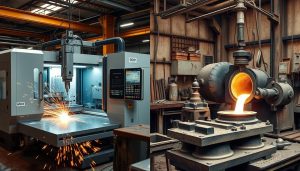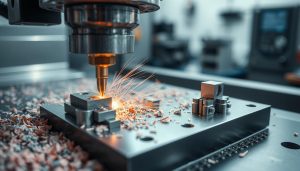In the ever-evolving world of healthcare, the materials used in medical devices and equipment play a crucial role in ensuring patient safety, durability, and performance. Understanding the top medical grade materials is essential for healthcare professionals, engineers, and patients alike. This article explores six of the most widely used medical-grade materials, delving into their unique properties, applications, and importance in the medical industry.
Key Takeaways
- Explore the top 6 medical grade materials used in healthcare today
- Learn about the unique properties and applications of each material
- Understand the importance of selecting the right medical grade material for healthcare products
- Discover how these materials contribute to patient safety, durability, and performance
- Stay informed on the latest advancements and trends in medical grade materials
Stainless Steel
Stainless steel is a popular choice for medical grade materials due to its exceptional strength, durability, and corrosion-resistant properties. This versatile alloy is commonly used in a wide range of medical applications, from surgical instruments to implants and medical equipment. Let’s explore the different types of stainless steel utilized in the healthcare industry and the benefits they offer.
Types of Stainless Steel for Medical Use
The medical industry primarily utilizes three main types of stainless steel:
- Austenitic Stainless Steel – This type is known for its exceptional corrosion resistance and is widely used in surgical instruments, implants, and other medical devices that require superior durability.
- Martensitic Stainless Steel – Characterized by its high strength and hardness, martensitic stainless steel is often employed in cutting tools, dental instruments, and other medical applications that demand a keen edge.
- Ferritic Stainless Steel – Ferritic stainless steel offers excellent formability and is frequently used in medical equipment housings, trays, and other non-critical components.
Benefits and Applications of Stainless Steel in the Medical Field
Stainless steel’s key advantages make it an ideal choice for medical grade materials:
- Corrosion Resistance: Stainless steel’s passive oxide layer protects it from corrosion, ensuring the long-term integrity of medical devices and implants.
- Strength and Durability: The high strength-to-weight ratio of stainless steel allows for the creation of lightweight yet robust medical instruments and equipment.
- Biocompatibility: Stainless steel is a biocompatible material, minimizing the risk of adverse reactions when used in medical implants and devices.
- Easy Sterilization: Stainless steel can withstand repeated sterilization processes, making it a preferred choice for surgical tools and other reusable medical items.
From surgical scalpels and clamps to orthopedic implants and dialysis machines, stainless steel plays a crucial role in the medical industry, providing corrosion-resistant and medical grade solutions that prioritize patient safety and clinical effectiveness.
Titanium
Titanium is a remarkable material that has gained significant prominence in the medical industry. Its exceptional properties, including high strength-to-weight ratio and unparalleled biocompatibility, make it an ideal choice for a wide range of medical applications. In this section, we will delve into the unique properties of titanium and explore its extensive use in implants, prosthetics, and other medical devices.
Properties of Titanium in Medical Applications
Titanium is prized for its exceptional strength, corrosion resistance, and ability to integrate seamlessly with the human body. Its biocompatibility is a crucial factor, as it minimizes the risk of rejection or adverse reactions from the patient’s immune system. This makes titanium an invaluable material for implants and prosthetic devices, ensuring a safe and effective long-term solution.
Use of Titanium in Implants and Prosthetics
Titanium’s unique properties have made it a go-to choice for a variety of medical implants and prosthetic devices. Some of the common applications of titanium in the medical field include:
- Orthopedic implants, such as hip and knee replacements
- Dental implants, including crowns, bridges, and dentures
- Cardiovascular implants, like pacemakers and stents
- Craniofacial implants, used to reconstruct the face and skull
- Spinal implants, including vertebral cages and fixation devices
The exceptional biocompatibility and strength of titanium make it a preferred choice for these critical medical applications, ensuring patient safety and long-term functionality of the implants.
“Titanium’s unique properties have made it a go-to choice for a variety of medical implants and prosthetic devices.”
As the medical industry continues to evolve, the demand for titanium and other high-quality medical grade materials is expected to rise. Manufacturers and healthcare providers must stay informed about the latest advancements in this field to ensure the best possible outcomes for patients.
Polycarbonate (PC)
In the world of medical devices, polycarbonate (PC) has emerged as a versatile and highly sought-after material. This transparent, durable plastic offers a unique combination of properties that make it an excellent choice for a wide range of medical applications.
Advantages of Polycarbonate in Medical Devices
Polycarbonate’s key advantages in the medical field include its exceptional impact resistance, optical clarity, and biocompatibility. Its remarkable strength and shatter-resistance make it an ideal material for devices that need to withstand the rigors of everyday use, ensuring patient safety and device longevity. Additionally, the material’s transparent nature allows for clear visibility, enabling healthcare professionals to monitor procedures and patient conditions effectively.
Medical Device Examples Using PC
Polycarbonate’s versatility is evident in the diverse range of medical devices that utilize this material. Some common examples include:
- Surgical instruments and tools
- Protective eyewear and face shields
- Syringes and other drug delivery systems
- Diagnostic equipment and imaging devices
- Dental and orthodontic appliances
- Incubators and other patient care equipment
These polycarbonate-based medical devices not only provide superior performance but also contribute to enhancing the overall patient experience and healthcare outcomes.
“Polycarbonate’s unique properties make it an indispensable material in the medical industry, delivering both functionality and patient safety.”
As the demand for innovative and reliable medical technologies continues to grow, polycarbonate’s role in shaping the future of the healthcare sector remains undeniable. Its exceptional qualities and versatility make it a leading choice for medical grade materials that prioritize patient well-being and operational efficiency.
Polyetheretherketone (PEEK)
In the world of medical grade materials, PEEK stands out as a true powerhouse. This high-performance polymer possesses a unique combination of exceptional mechanical properties, excellent chemical resistance, and superior biocompatibility – making it an ideal choice for a wide range of medical applications.
What Makes PEEK Ideal for Medical Use?
PEEK is valued in the medical field for its remarkable durability, strength, and flexibility. Its exceptional mechanical grade materials enable it to withstand the rigors of demanding medical environments, ensuring reliable and long-lasting performance. Additionally, PEEK exhibits exceptional chemical resistance, allowing it to withstand exposure to a variety of disinfectants and sterilization processes without compromising its integrity.
Importantly, PEEK is also highly biocompatible, meaning it can be safely integrated into the human body without adverse reactions or complications. This makes it a preferred choice for medical devices and implants that require direct contact with biological tissues.
Applications of PEEK in the Medical Field
PEEK finds widespread use in the medical field, with applications ranging from orthopedic implants to dental devices. Its unique properties make it well-suited for the following medical applications:
- Orthopedic implants: PEEK is commonly used in the production of joint replacements, spinal cages, and other orthopedic implants due to its excellent biocompatibility and mechanical properties.
- Dental devices: PEEK is increasingly being used in the manufacture of dental implants, crowns, and other dental prosthetics, providing a durable and aesthetically pleasing solution.
- Medical instruments: The high-performance polymer characteristics of PEEK make it an ideal material for surgical instruments, providing exceptional durability and resistance to sterilization processes.
- Medical imaging equipment: PEEK is commonly used in the production of components for medical imaging equipment, such as MRI and CT scanners, due to its low interference with electromagnetic fields.
As the demand for innovative and reliable medical solutions continues to grow, PEEK is poised to play an increasingly vital role in the medical industry, serving as a versatile and high-performance material for a wide range of medical applications.

Magnesium in Medical Applications
As medical technology continues to evolve, the demand for innovative and biocompatible materials has grown exponentially. Among the materials gaining traction in the industry is magnesium, a remarkable element with unique properties that make it a compelling choice for various medical applications.
Magnesium is a biodegradable and highly biocompatible metal, meaning it can be safely integrated into the human body without causing adverse reactions or long-term complications. This characteristic makes magnesium an ideal candidate for the development of temporary implants and other medical devices that need to be absorbed or replaced over time.
The Advantages of Magnesium in Medical Grade Materials
Magnesium offers several advantages that make it a standout choice for medical grade materials:
- Biodegradability: Magnesium-based implants and devices can gradually break down and be absorbed by the body, eliminating the need for additional surgical procedures to remove them.
- Biocompatibility: Magnesium is highly compatible with human tissue, reducing the risk of rejection or adverse reactions.
- Mechanical Properties: Magnesium has a similar density and strength to human bone, making it well-suited for orthopedic applications such as bone fixation devices and implants.
- Osteoconductive Properties: Magnesium can actively promote the growth of new bone tissue, enhancing the integration of implants and devices.
Applications of Magnesium in the Medical Field
The unique properties of magnesium have led to its increasing use in a variety of medical applications, including:
- Biodegradable Implants: Magnesium-based implants are being developed for bone, cardiovascular, and other tissue regeneration applications, where they can gradually dissolve and be replaced by natural body tissues.
- Orthopedic Devices: Magnesium is used in the production of orthopedic screws, plates, and other fixation devices to support bone healing and remodeling.
- Cardiovascular Stents: Magnesium-based stents can provide temporary support for blood vessels, gradually dissolving as the vessel heals and restores its natural function.
As the medical industry continues to prioritize the development of safe, biocompatible, and biodegradable solutions, magnesium is poised to play an increasingly crucial role in the field of medical grade materials.
Polyvinyl Chloride (PVC) in Medical Devices
Polyvinyl Chloride, or PVC, is a versatile and widely used medical grade material that has become an integral part of the healthcare industry. This flexible plastic is commonly found in a variety of medical devices, from tubing and blood bags to IV sets and catheters. Its unique properties make it an ideal choice for these applications, offering both functionality and patient safety.
One of the key advantages of PVC in medical devices is its flexibility and durability. PVC is a lightweight yet durable material that can withstand the rigors of medical use without compromising its structural integrity. This makes it well-suited for devices that need to be flexible, such as tubing and catheters, while still maintaining a high level of strength and reliability.
Another important factor in the use of PVC in medical devices is its ability to be sterilized. PVC can be easily sterilized using a variety of methods, including gamma radiation, ethylene oxide, and autoclaving. This ensures that these medical devices are safe for use, reducing the risk of infection and promoting patient well-being.
In addition to its physical properties, PVC is also a cost-effective material for medical device manufacturers. Its relatively low production cost and wide availability make it a popular choice for a variety of medical applications, from single-use items to more complex, reusable devices.
Overall, the use of PVC in medical devices has become an essential component of modern healthcare. Its combination of flexibility, durability, and sterilization capabilities make it a reliable and versatile medical grade material that continues to play a crucial role in the delivery of quality patient care.

| PVC Medical Device Examples | Key Benefits |
|---|---|
| Tubing | Flexibility, durability, cost-effectiveness |
| Blood bags | Sterility, flexibility, compatibility with blood products |
| IV sets | Flexibility, transparency, resistance to kinking |
| Catheters | Flexibility, biocompatibility, ease of insertion |
Choosing the Right Medical Grade Material for Your Product
Selecting the appropriate medical grade material is a crucial step in the product development process. When it comes to creating medical devices or equipment, the choice of material can make all the difference in terms of safety, performance, and regulatory compliance. Here are some key factors to consider when choosing the right medical grade material for your product:
- Regulatory Requirements: Ensure the material you select meets all necessary regulatory standards and certifications, such as FDA approval or ISO 13485 compliance, depending on the intended use of your product.
- Sterilization Methods: Consider the sterilization process your product will undergo and choose a material that can withstand the necessary sterilization techniques, whether it’s autoclaving, gamma radiation, or chemical disinfection.
- Performance Characteristics: Evaluate the physical, mechanical, and chemical properties of the material to ensure it can withstand the demands of your product’s intended use, such as biocompatibility, durability, and resistance to corrosion or wear.
- Manufacturing Capabilities: Assess your manufacturing capabilities and choose a material selection that can be easily processed and shaped to meet the design requirements of your product.
By carefully considering these factors, you can ensure that you select the best medical grade material for your product, optimizing its performance, safety, and compliance with industry standards. This will not only enhance the quality of your product but also streamline the product development process and increase the chances of successful market introduction.
“Choosing the right medical grade material is a critical decision that can make or break the success of a medical product.”
Why Shixinproto Is Your Trusted Partner for Medical Grade Material Solutions?
When it comes to medical grade materials, Shixinproto stands out as a dependable and experienced partner. With a deep understanding of the stringent requirements in the healthcare industry, Shixinproto offers expertise in selecting and manufacturing the most suitable materials for a wide range of medical applications.
Shixinproto’s commitment to quality is reflected in their rigorous testing and validation processes, ensuring every medical grade material they provide meets the highest industry standards. From stainless steel and titanium to advanced polymers like polycarbonate and PEEK, the company’s extensive knowledge and state-of-the-art facilities enable them to deliver exceptional solutions tailored to your specific needs.
Whether you’re developing innovative medical devices, constructing robust implants, or seeking reliable materials for healthcare infrastructure, Shixinproto is your trusted partner. Their team of experts will guide you through the selection process, offering valuable insights and support to help you make informed decisions. With Shixinproto by your side, you can be confident in the quality, performance, and regulatory compliance of your medical grade material solutions.





